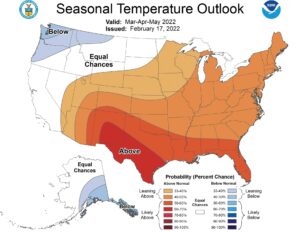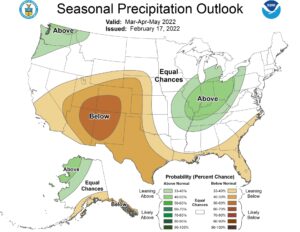February has brought all kinds of precipitation to the state and now conditions are muddy if not flooded. Will this continue? The national Climate Prediction Center just released their 1-month and 3-month climate outlooks for March and March-May periods, respectively. Both are conveying the same story, which is heavily influenced by our ongoing La Niña event. There is significant confidence that temperature for these time periods will average above normal and precipitation will be above normal (Figures 1 and 2). Therefore, anticipate saturated soils as conditions begin to thaw progressing into spring. Flooding may continue to be a concern. For the March-through-May period, while outlooks are favoring above-normal precipitation, this is in consideration of the full 3-month period being averaged. It is possible that this translates to the earlier weeks of that period being wetter than the later weeks. However, due to La Niña continuing (though weakening) into the spring, this chance is not too likely, but there is always hope.

Figure 1. The temperature outlook for March-April-May presented as the level of confidence for above- or below-normal temperature. Source: NOAA Climate Prediction Center

Figure 2. The precipitation outlook for March-April-May presented as the level of confidence for above- or below-normal precipitation. Source: NOAA Climate Prediction Center
As usual, the past few months have felt like a roller coaster ride regarding climate. November was particularly dry with cooler-than-normal temperatures. While possibly ideal for some agricultural considerations, this raised some concerns that drought may be developing. However, December was considerably warmer than normal with above-normal precipitation (with the exception along the Ohio River). This was a more typical La Niña pattern where the winter season is often warmer and wetter than normal. The La Niña was fully established by this point, so the assumption was that temperatures would stay mild and warm with precipitation likely falling more as rain than snow until later in the season. Unfortunately, January was remarkably dry and seasonably cool. Could the La Niña outlook have been wrong? February decided to declare that winter was not over yet and La Niña events typically shine strongest in February. Alas, this month we have seen lots of rain, ice, sleet, and snow. Temperatures have been cooler than normal – which has helped bring the snow we had been missing so far this season – reminding us all (along with our faithful groundhog) that winter is not over yet.
For agriculture though, the big question will be how long with this all last and will we be looking at a cool, wet spring much like 2019, or will La Niña fade away and bring a typical Indiana spring with strong variability in both temperature and precipitation? Currently, climate outlooks into April are showing confidence in above-normal temperature and above-normal precipitation. It is too soon to know how this will translate come planting time, so for now we must continue cuddling up in our warm blankets and watch the next winter storm event as it reminds us that Mother Nature can be more determined than we are.